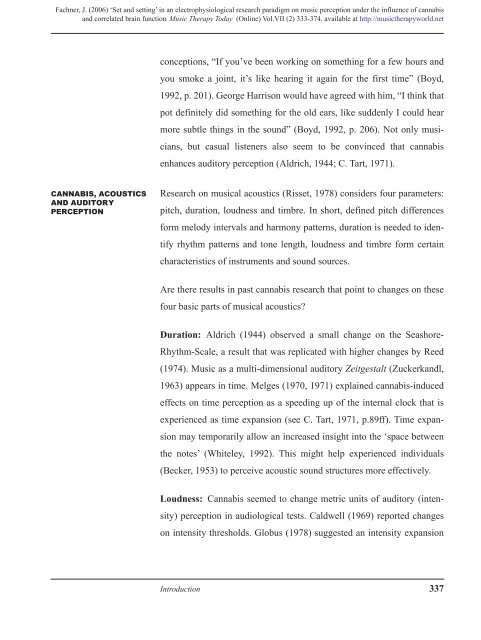Music Therapy Today - World Federation of Music Therapy
Music Therapy Today - World Federation of Music Therapy
Music Therapy Today - World Federation of Music Therapy
Create successful ePaper yourself
Turn your PDF publications into a flip-book with our unique Google optimized e-Paper software.
Fachner, J. (2006) ‘Set and setting’ in an electrophysiological research paradigm on music perception under the influence <strong>of</strong> cannabis<br />
and correlated brain function. <strong>Music</strong> <strong>Therapy</strong> <strong>Today</strong> (Online) Vol.VII (2) 333-374. available at http://musictherapyworld.net<br />
CANNABIS, ACOUSTICS<br />
AND AUDITORY<br />
PERCEPTION<br />
conceptions, “If you’ve been working on something for a few hours and<br />
you smoke a joint, it’s like hearing it again for the first time” (Boyd,<br />
1992, p. 201). George Harrison would have agreed with him, “I think that<br />
pot definitely did something for the old ears, like suddenly I could hear<br />
more subtle things in the sound” (Boyd, 1992, p. 206). Not only musi-<br />
cians, but casual listeners also seem to be convinced that cannabis<br />
enhances auditory perception (Aldrich, 1944; C. Tart, 1971).<br />
Research on musical acoustics (Risset, 1978) considers four parameters:<br />
pitch, duration, loudness and timbre. In short, defined pitch differences<br />
form melody intervals and harmony patterns, duration is needed to iden-<br />
tify rhythm patterns and tone length, loudness and timbre form certain<br />
characteristics <strong>of</strong> instruments and sound sources.<br />
Are there results in past cannabis research that point to changes on these<br />
four basic parts <strong>of</strong> musical acoustics?<br />
Duration: Aldrich (1944) observed a small change on the Seashore-<br />
Rhythm-Scale, a result that was replicated with higher changes by Reed<br />
(1974). <strong>Music</strong> as a multi-dimensional auditory Zeitgestalt (Zuckerkandl,<br />
1963) appears in time. Melges (1970, 1971) explained cannabis-induced<br />
effects on time perception as a speeding up <strong>of</strong> the internal clock that is<br />
experienced as time expansion (see C. Tart, 1971, p.89ff). Time expan-<br />
sion may temporarily allow an increased insight into the ‘space between<br />
the notes’ (Whiteley, 1992). This might help experienced individuals<br />
(Becker, 1953) to perceive acoustic sound structures more effectively.<br />
Loudness: Cannabis seemed to change metric units <strong>of</strong> auditory (inten-<br />
sity) perception in audiological tests. Caldwell (1969) reported changes<br />
on intensity thresholds. Globus (1978) suggested an intensity expansion<br />
Introduction 337

















